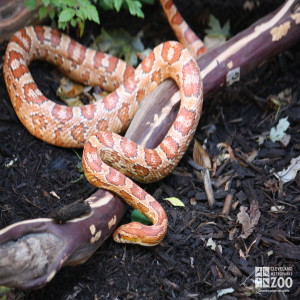Snake, Corn
[Elaphe guttata]

The corn snake is 24 to 72 inches long with orange or brownish–yellow coloring. They have large black-edged red blotches down the middle of the back and alternating rows of black and white marks on their belly like a checker board pattern. Newborns are not as brightly colored as the adults.
Location: Animals Formerly at Zoo
Share:
Range
The corn snake ranges in the eastern United States from southern New Jersey through Florida; west into Louisiana and parts of Kentucky.
Habitat
Corn snakes inhabit wooded groves, wood lots, meadows, barns, and abandoned buildings.
Conservation Status
Primary Threats
Gestation
Corn snakes incubate eggs for about 2 months.
Litter
Clutch size: 10 to 30 eggs
Behavior
Corn snakes are mostly diurnal, climbing trees and going into abandoned buildings looking for food. They are very secretive, spending most of their time underground in rodent burrows or hiding under loose bark, logs, or rocks.
Reproduction
Corn snakes breed from March to May. They deposit their eggs in late May to July in rotting vegetation or similar locations with enough heat and humidity to incubate them at about 82 degrees F. Hatchlings are 10 to 15 inches long and mature in 18 to 36 months.
Wild Diet
The young feed on lizards and tree frogs; adults on larger animals (i.e. mice, rats, birds and bats). They do not eat every day.
Zoo Diet
Mice, rats and chicks
